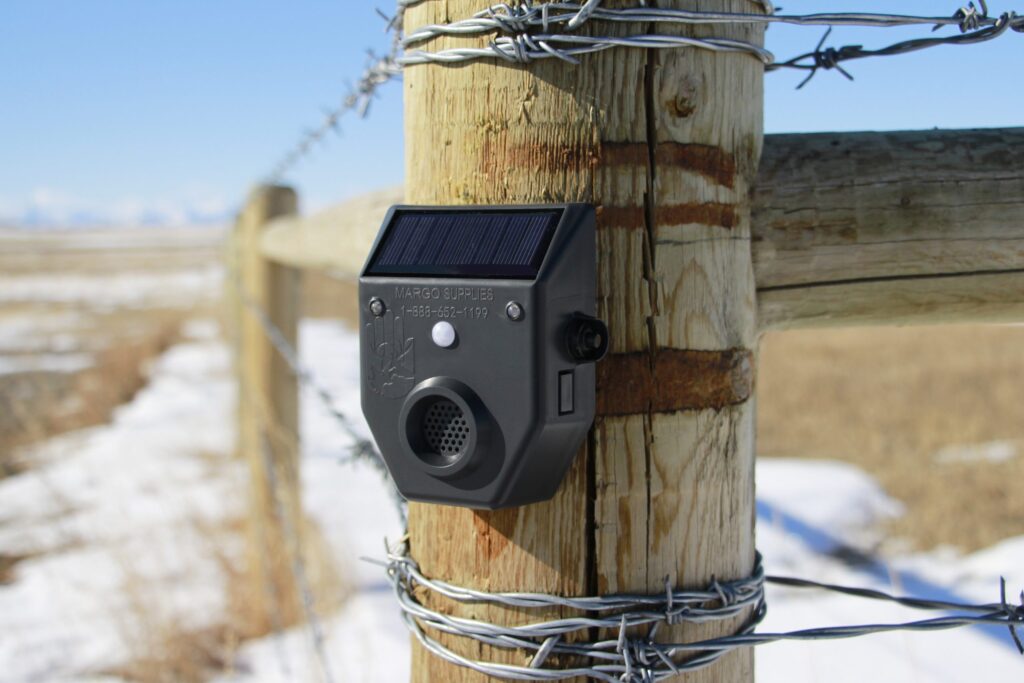Margo Luminous Tracking Collar: The Future of Wildlife Tracking Technology

About The Margo Luminous Tracking Collar is the result of four years of re-imagining wildlife tracking technology. We incorporated a single housing design, solar charging, and state-of-the-art reception which unlocks performance never before seen in a two-way satellite tracking collar. Our 170g device can collect hourly GPS fixes on a long-term basis and in ideal conditions will relay position to our web interface seconds after collection – allowing near real-time monitoring. After extensive field testing, we are excited to release this product to the larger wildlife community. COLLAR FEATURES REPORTING FEATURES:
Margo Critter Guard : A Versatile Wildlife Deterrent

Introducing Margo Critter Guard Features: Motion Detection up to 35ft away 160-degree angles of motion detection 3.6w rechargeable solar-powered battery 105dB sirens 7500mcd LEDs Weatherproof The Margo Critter Guard is a Margo Original product is effective at scaring a large variety of wildlife with its motion-activated siren alarm and flashing scare eye. Portable, sturdy, and weather-resistant, the Critter Guard protects against most mammals. From deterring elk from feeding on haystacks, deer eating in vegetable gardens, or even cougars from attacking livestock, the Critter Guard does it all. Protect your land and other assets from predators, wildlife, and other animals with a universal, and affordable solution. This product is a nuisance to animals, making favorable areas undesirable for habitation, feeding, or interfering with your property. Iris GadunovLandowner Read More We hope that people start using the alarm and more people understand that we can live with these predators. When the lions were tracked, we saw that they stalked the perimeter of the Critter Guard so we can see that they are effective. How it Works: The Critter Guard relies on motion-activated sirens and red flashing lights to deter wildlife. Because of this, users can customize their experience based on what they need. The motion sensors can detect movement at a 160-degree angle, with a sensitivity range of 10 to 35ft. When an animal is within range of the Critter Guard, the motion-detector will trigger a combination of piercing wailing and flashing red predator lights, signaling to animals that trespassing in this area is dangerous. The Design: The Critter Guard was designed with every environment in mind. Utilizing a rugged and solar-powered design allows for portable and reliable placement, wherever you may need to keep wildlife away. The adjustable sensitivity and multiple light settings allow the user to customize their wildlife deterrent strategy with ease. The back of the Critter Guard includes three holes for mounting convenience. Range: 160-degree detection angle A variable sensitivity switch allows users to fine-tune the alarm to their ideal conditions. Variable sensitivity (10ft – 35ft) Sound: Up to 105dB sirens with three different modes. A variable sensitivity switch allows users to fine-tune the alarm to their ideal conditions. Testing: Tested in both arctic and rainforest environments and everything in between, the Margo Critter Guard is a staple in wildlife deterrent technology. It is great to deter both small and large animals without requiring regular maintenance. https://www.youtube.com/watch?v=ynynSmnHvS8&t=16s Critter Guard Manual
How Effective Are Bird Lasers?

Bird lasers produce a large visible point of light that can be used to scare away problem birds. Many bird species associate this light with a predator like behavior and flee when exposed to the visible light pattern. The most effective bird lasers produce a wide beam, as opposed to a narrow beam in the conventional laser pointers. Green beams generally seem to produce the best results. Bird lasers have a number of control applications but are especially useful for moving birds from their roosts. At Margo Supplies, we’ve tested lasers on a variety of North American pest species with good results overall and have found them to be especially effective on Canada Geese. Lasers are particularly useful in situations where it is not possible to use other more invasive audio deterrents, such as disturbing birds from roosts in and around warehouses, barns, and close to airport terminals. An effective technique is to repeatedly treat roosting sites at dawn and at dusk, this gives birds time to find alternative roosts outside your control area. Diurnal birds will typically not flee a roost area in full dark, no matter how much pressure you put them under so it is important to begin laser treatment as soon as they return back to their roost. The most effective technique is to use the beam of light to slowly approach the roosting site, remember that birds perceive the laser light as a predator-like presence and so you must leave them an escape path. For indoor use, use the laser beam to “herd” birds towards and exit. While bird lasers can be an effective deterrent, many jurisdictions have laws prohibiting high-power lasers. In Canada, only handheld lasers with an output of >5mW are allowed (class 3a or lower), such as our Bird Scare Laser. Power restrictions do somewhat limit laser applications as these lasers will not produce a very visible light during bright daylight. However, we’ve found these tools to be especially effective at chasing birds from roosts sites, which is typically done in low light situations. In addition, high-power lasers can pose safety hazards, particularly in aviation environments. As with all deterrents, bird lasers have both strengths and drawbacks and should be looked at as one tool in your bird control toolbox. Using a wide variety of affordable tools allows your team to react to diverse species and situations while preventing birds from becoming habituated from one type of deterrent.
From Fruit to Fences: How I Became a Leader in Wildlife Management

My name is Jeff Marley and I’m the founder and owner of Margo Supplies. Working on my wife’s family orchard, I quickly learned how wildlife damage can impact total yields.

